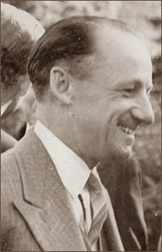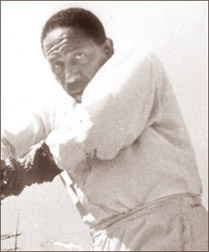Who is the better
cricketer?
Sir Donald Bradman or Sir Learie Constantine
by A. C. de Silva
|

Sir Donald Bradman
|
CRICKET: Sir Donald Bradman captained Australia from 1936 until his
retirement in 1948. I doubt whether he was adored by his team-mates- he
was too withdrawn, most aloof, for that. In farewell to cricket, he
explained, with typical clarity his position. He died at the age of 92
years in Adelaide, Australia.Bradman's break-up of centuries: vs England
19, vs South Africa 4, vs West Indies 2 and vs India 4.
There is a school of thought that it was surely enough that he should
be the best batsman of all time without having to be the most
high-scoring player, and it is worth noting, that Australia lost none of
the five "rubbers" they contested during the period of his captaincy.
Meticulous preparations and his own prolific run scoring saw to that.In
the 1930 series, Bradman finished with a total average of 974 runs at an
average of 139.14, figures which clearly illustrated the scale of the
problem confronting the English selectors when they sat down to discuss
who should lead the 1932-33 English side to Australia.In the 1930 series
against England, July 11 at Leeds to be exact, Don Bradman became the
first batsman to score 300 runs in a day. He made 334 runs - with 130
runs coming before lunch, 115 runs between lunch and tea and 89 runs in
the final session.
Cricket writer Neville Cardus once said that if he was given the
opportunity of reliving just one match of all those he had seen, he
would choose the Lord's Test of 1930, `the match of every cricketers
heart's desire. That match was played in glorious summer weather, the
game produced 1,601 runs in under four days.
The match was won by Australia and by the young Don Bradman, making
his first appearance for his country at Lord's by scoring a double
century that remained for 60 years the highest Test score made at that
ground.
Intimidatory lead
Nearly every ball was scored from. Bradman ran yards out of his
ground to White and dealt severe blows. White was obliged to pitch short
and then Bradman out him to ribbons. After tea it was a massacre and
nothing else. Never before has there been such a powerful display of
batting after the tea interval until close of play, by a batsman - and
in this instance it was Bradman's cool deliberate "murder" of the
English bowling..... every shot so elegant that it caught the fancy of
cricket followers. Bradman's century came in 95 minutes and an hour
later - that's at close of play, his score was 155 and never did he left
a shot or take a risk. On the third day, Bradman consolidated spending
another three hours building his score to 254 when Chapman caught him
off the bowling of White. After the departure of young Bradman Australia
went on belligerently to a declaration at 729 for 6 an intimidatory
first innings lead of 304. England: 425 and 275.
Australia: 729 (Don Bradman 254 - caught by Chapman b White). (A.C.
De S.)
|

Sir Learie Constantine
|
CRICKET: Who was the most exciting Test cricketer in those early
years, say late 1920s and early 1930s? There are two names that crop up
for early pickings. They are: Sir Donald Bradman of Australia and West
Indian Sir Learie Constantine. Of the names mentioned, which one is
considered the better cricketer? On a distant day, the question was put
to Patsy Hendran for his opinion.Constantine enthraled crowds in a
certain way as Gilbert Jessop had done in the 1990s, whether batting,
bowling or fielding.
Consider his performance for the West Indies against Middlesex in
June 1928. Going to the crease at 79 for 5 wickets, he made 86 out of
107 in less than an hour, thereby saving the follow-on.
Constantine's Test figures are not a true reflection of his worth (a
batting average of 19.24, a bowling average of 30.10) as compared
against stalwarts like-George Headley who was one of four players (Bradman,
Graeme Pollock and Sutcliffe are the others) who averaged over 60 in
Test cricket.Lord Constantine, MBE, died in London on July 1, 1971,
having been born on September 21, 1902.He made his mark in the only way
a poor West Indian way of his time could do, by playing cricket through
his own ability and character.
Patsy Hendren - was the prince of middle-order batsmen in the good
old days and when asked to name the most exciting cricketer he's over
known. It was a known fact that Hendren much admired Bradman, Hammond
and that tigerish man Bill O-Reilly. But, without hesitation, he gave
Learie Constantine the nod.
Hendren had seen the West Indian allrounder Sir Learie Constantine in
his declining years and so was in no position to judge. But the choice
surprised him just the same.
Constantine's career record was pointed out - 641 runs in Tests for
an average of 19.42 and 58 wickets for an average of 30.10 - scarcely
seemed to merit such a place in the sun. And Hendren, the most mellow of
men, smiled patiently and said, "There are some players you just can't
judge by the book, and Constantine was one of those. When it really
mattered he was a man who could do the most amazing thing."Constantine
was a hurricane hitter, a hurricane bowler and a hurricane fielder too.
His rate of striking was second only to the mighty Gilbert Jessop in the
annals of the first-class game.
Fielding exploits
Hendren illustrated the point with a story of one of Constantine's
more remarkable fielding exploits. From cover point he had thrown down
the wicket at the batsman's end, gathered up the rebound and, in the
same flowing motion, flattened the stumps at the far end. "Both batsmen
were safely home," recounted Hendren. "But if there had been any
justice, they would have given Learie two wickets, because this was the
mark of genius."
On another occasion, Hendren, with his fine humour, had walked out to
bat against Constantine at Lord's wearing a crash helmet ....an unheard
of thing in the Thirties. Apart from having a bit of fun, Hendren was
also gently making a point. |

